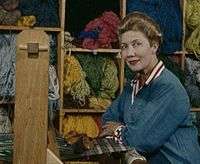Dorothy Liebes
| Dorothy Liebes | |
|---|---|
|
Dorothy Liebes in her studio | |
| Born |
14 October 1897 Santa Rosa, California |
| Died |
20 September 1972 (aged 74) New York City |
| Nationality | American |
| Education | San Jose State Teacher's College; University of California, Berkeley; Hull House, Chicago |
| Occupation | Textile Designer |
| Spouse(s) |
Leon Liebes (m. 1928–40) Relman Morin (m. 1948–72) |
| Awards | 1938 Neiman Marcus Fashion Award, 1946 American Institute of Decorators award, 1947 American Institute of Architects Craftsmanship Medal, 1948 Elsie de Wolfe Award |
Dorothy Wright Liebes (1897–1972) was an American textile designer and weaver renowned for her innovative, custom-designed modern fabrics for architects and interior designers.[1] She was known as "the mother of modern weaving".[2]
Early life
Born Dorothy Wright on October 14, 1897, in Santa Rosa, California, she was the daughter of Frederick L. Wright, a chemistry professor, and Bessie Calderwood Wright, a teacher.[3] While studying anthropology, art, and teaching at San Jose State Teacher's College and at the University of California, Berkeley, she was advised to experiment with textile design.[3] She bought a small portable loom and taught herself how to weave.[1]
In 1928, she married Leon Liebes, a businessman. They divorced in 1940, although Dorothy Liebes retained his surname professionally. In 1948 she married the Pulitzer Prize-winning journalist, Relman Morin.
Career
After several years as a schoolteacher, Liebes decided to become a textile designer, and studied weaving at Hull House, Chicago, and made study trips to France, Italy, Guatemala, and Mexico to learn about traditional weaving forms.[3] Her first studio, Dorothy Liebes Design, Inc. was opened in 1937, though her husband opposed, in San Francisco.[4] By 1938 she had seventeen men and women working in her studio.[4] Following demand, she opened a second studio in New York.[3] She relocated full-time to New York City in 1948.[1][5]
Her fabrics were known for their bold colour combinations and interesting textures, and often used unexpected materials such as feathers, plastics, metallics, jute, ticker tape, leather strips, and bamboo.[1][5] They were commissioned by architects, including Frank Lloyd Wright, Edward Durell Stone, Miller and Pflueger and Samuel Marx.[1][6] Other clients included King Ibn Saud of Saudi Arabia, the Ahwahnee Hotel in Yosemite, and the Paramount Theatre in Oakland, California.[2][7] Her textiles were also used in airplanes, ocean liners, theatres and hotels.[2]
Liebes was a design consultant for companies such as DuPont, Dow, Bigelow-Sanford, and Goodall Fabrics of Sanford, Maine.[3] A promoter of textile mass-production, she advised on the development of synthetic fibres, and assisted in the development of machinery that could replicate the aesthetic irregularities and unevenesses of hand-loomed fabrics.[3][5] From 1955 to 1971 Liebes acted as DuPont's home furnishings consultant. As a spokesperson for the company, she helped the general public overcome adversities to synthetic fabrics.[8]
Awards
Liebes was one of the first recipients of the Neiman Marcus Fashion Award at their launch in 1938. In 1946, one of her designs was chosen best textile by the American Institute of Decorators[9] The following year, 1947, she received The Craftsmanship Medal from the American Institute of Architects.[5] She also received prizes and awards from Lord & Taylor, the Paris Exposition, and the Architectural League.[3] In 1948, she received an honorary degree from Mills College and the Elsie de Wolfe Award.[3] Death
Due to a heart condition, Dorothy Liebes semi-retired in 1971.[3] She died in New York City on September 20, 1972.
Legacy
Her work is held in the collection of the Cooper-Hewitt, National Design Museum.[10] The Art Institute of Chicago, and the Phoebe A. Hearst Museum of Anthropology at University of California, Berkeley.
References
- 1 2 3 4 5 "Dorothy Liebes: Sample room divider (1973.129.7)". In Heilbrunn Timeline of Art History. New York: The Metropolitan Museum of Art, 2000–. http://www.metmuseum.org/toah/hd/dsgn2/ho_1973.129.7.htm (October 2006)
- 1 2 3 Olsen, Kirstin (1994). Chronology of women's history. Greenwood Publishing Group. p. 326. ISBN 0-313-28803-8.
- 1 2 3 4 5 6 7 8 9 About the Dorothy Liebes Papers at the Smithsonian Institution's Archives of American Art, accessed 31 January 2012]
- 1 2 Winton, ALEXANDRA GRIFFITH (Spring 2009). "COLOR AND PERSONALITY: Dorothy Liebes and American Design". Archives of American Art Journal. 48 (1-2).
- 1 2 3 4 Fiber Art: Following The Thread: Dorothy Liebes Papers at the Smithsonian Institution's Archives of American Art, accessed 27 March 2009.
NB: As of January 2012, most of the information from this source has been relocated here. - ↑ "Paramount Theatre History". Paramount Theatre. Retrieved November 7, 2014.
- ↑ History of the Paramount Theatre, Oakland, California, accessed 27 March 2009
- ↑ Blaszczyk, Regina Lee (2008). "Designing Synthetics, Promoting Brands: Dorothy Liebes, DuPont Fibres and Post-war American Interiors". Journal of Design History.
- ↑ Decorator's Choice, TIME Magazine, Monday 13 January 1947
- ↑ Dorothy Wright Liebes | People | Collection of Smithsonian Cooper-Hewitt, National Design Museum


